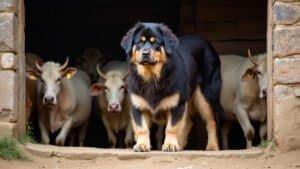Introduction
In regions where snow leopards roam, protecting livestock has long been a priority for herders. This article delves into the traditional methods used by herders to safeguard their animals from these elusive predators
We’ll explore the construction and effectiveness of stone corrals, the use of specially trained guard dogs, and the night watch techniques passed down through generations
Additionally, we’ll examine various traditional deterrents and alarm systems that have been developed to keep snow leopards at bay, and how these methods are sometimes combined with modern technology
Stone Corrals and Their Effectiveness
For centuries, herders living in mountainous regions have relied on stone corrals as a primary defense against snow leopard attacks on livestock
These structures, often made from locally sourced stones, serve as a sturdy barrier to protect animals from predators during the night. The design and construction of these corrals are deeply rooted in the local culture, reflecting the ingenuity of communities that have coexisted with wildlife for generations
How Stone Corrals are Constructed
Stone corrals are traditionally constructed using rocks and stones readily available in the surrounding environment. The walls of these corrals are built high and thick, with the intention of making them impenetrable to predators like snow leopards
The height of the walls is particularly important, often reaching over six feet, as snow leopards are known for their ability to leap great distances. The thickness of the walls, sometimes over two feet, helps ensure that even if a leopard were to try and climb, the structure would hold firm
The floor of the corral is typically leveled and may be covered with straw or dirt to provide a comfortable surface for the livestock
A single entrance is usually included, often secured with a wooden gate reinforced with metal or additional stones to prevent forced entry. The corral is usually located close to the herder’s home or within the village, allowing for quick response in case of an attack
The location of the corral is carefully chosen to minimize exposure to potential predators. Often, these corrals are built near cliffs or steep terrain, which further complicates any attempts by predators to access the livestock
The strategic placement of these structures is a testament to the deep understanding herders have of their environment and the threats posed by local wildlife
Case Studies of Corral Effectiveness
Numerous case studies highlight the effectiveness of stone corrals in protecting livestock. For instance, in the remote regions of Ladakh in northern India, herders have reported significant reductions in livestock losses after constructing and fortifying stone corrals
One study published by the Snow Leopard Conservancy in 2015 noted that herders who implemented traditional stone corrals experienced up to a 70% decrease in predation events
In Mongolia, the use of corrals has been an essential part of pastoral life for centuries. A report by the World Wide Fund for Nature (WWF) in 2017 documented that in areas where herders maintained well-constructed stone corrals, the instances of snow leopard attacks on livestock were far lower compared to regions where such structures were absent or poorly maintained
These examples underscore the critical role that stone corrals play in the daily lives of herders and their livestock. The success of these structures is largely due to their robust design, strategic placement, and the cultural knowledge passed down through generations
Potential Limitations of Corrals
While stone corrals are highly effective, they are not without limitations. One significant challenge is the labor and time required to construct and maintain these structures
In many remote regions, sourcing the appropriate materials and building a sturdy corral can be a considerable undertaking, often requiring community effort and resources
Additionally, corrals are not always foolproof. There have been instances where snow leopards, driven by hunger or persistence, have managed to breach these barriers. For example, in particularly harsh winters, when prey is scarce, snow leopards may be more determined in their attempts to access livestock, leading to rare but significant breaches
Another limitation is that while corrals are effective during the night when livestock is confined, they offer no protection during the day when animals are grazing in open pastures. In these situations, herders must rely on other methods, such as guard dogs or active monitoring, to prevent attacks
Finally, there is the issue of scalability. In areas with large herds or where multiple families share grazing lands, constructing sufficient numbers of stone corrals can be challenging. In some cases, herders might need to explore alternative or supplementary methods to ensure the safety of their livestock
Guard Dogs as Livestock Protectors
Guard dogs have been an indispensable part of traditional livestock protection in regions threatened by snow leopards. These dogs are not only valued for their loyalty and courage but also for their ability to deter predators through their presence and behavior
Trained specifically for the purpose of guarding, these dogs have played a crucial role in safeguarding livestock and supporting the livelihood of herders in remote, mountainous areas
Breeds Best Suited for Guarding Livestock
Several dog breeds have proven particularly effective in guarding livestock from predators like snow leopards
Among the most commonly used are the Tibetan Mastiff, the Anatolian Shepherd, and the Central Asian Ovcharka. These breeds are characterized by their large size, strength, and instinctive protective nature, making them well-suited for the task
The Tibetan Mastiff, native to the Himalayan region, is a breed that has been used for centuries by nomadic herders
Known for its thick coat, which provides protection against the harsh mountain climate, and its fearless demeanor, this breed is highly effective in deterring predators. Tibetan Mastiffs are known for their loyalty to their owners and their willingness to confront threats without hesitation
The Anatolian Shepherd, originating from Turkey, is another breed renowned for its guarding abilities. This breed is highly independent, intelligent, and known for its strong territorial instincts. Anatolian Shepherds are particularly valued for their ability to work independently, making them ideal for protecting livestock in vast, open areas where herders may not always be present
The Central Asian Ovcharka, also known as the Central Asian Shepherd Dog, is a breed that has been used by herders across Central Asia for thousands of years
This breed is exceptionally strong and possesses a natural instinct to protect its flock. Central Asian Ovcharkas are known for their courage and resilience, often standing their ground against large predators like snow leopards
Training Methods for Guard Dogs
Training guard dogs to protect livestock from snow leopards requires a combination of natural instincts and learned behavior. The process typically begins when the dogs are still puppies, as early exposure to livestock helps them bond with the animals they will later protect
Puppies are often introduced to the flock at a young age, allowing them to grow up alongside the livestock. This early socialization is crucial as it helps the dogs see the animals as part of their pack, fostering a protective instinct. Herders will usually provide minimal intervention during this period, allowing the puppy’s natural instincts to develop
As the dog matures, training becomes more structured. Herders teach the dogs to respond to commands and condition them to recognize the signs of a predator’s approach. For example, dogs may be trained to bark loudly at unfamiliar scents or movements near the herd, which serves as both a warning to the herder and a deterrent to the predator
Guard dogs are also trained to stay with the herd at all times, even during grazing. This constant presence is essential in preventing snow leopard attacks, as the dogs can detect and confront predators before they get too close
In some cases, guard dogs may work in pairs or small groups, which increases their effectiveness by allowing them to cover more ground and provide mutual support during an encounter with a predator
Success Stories of Guard Dogs in Action
There are numerous success stories highlighting the effectiveness of guard dogs in protecting livestock from snow leopards
In Kyrgyzstan, a region known for its snow leopard population, a project led by the Snow Leopard Trust has provided local herders with specially trained Central Asian Ovcharkas. This initiative has led to a significant reduction in livestock losses
According to a report by the Snow Leopard Trust in 2018, herders who participated in the program saw a decrease of over 60% in predation incidents after the introduction of guard dogs
In Bhutan, the use of Tibetan Mastiffs has been integral to the protection of yak herds. Herders in the region have long relied on these dogs to guard their animals, particularly during the summer grazing season when yaks are most vulnerable. The Bhutanese government has even supported breeding programs to ensure that herders have access to these valuable dogs
A 2019 study published in the journal Global Ecology and Conservation highlighted that herders using Tibetan Mastiffs reported fewer snow leopard attacks compared to those without guard dogs
These success stories underscore the critical role that guard dogs play in traditional livestock protection. Their effectiveness is not only due to their physical attributes and training but also because of the deep bond they share with the livestock and the herders who rely on them
Night Watch Techniques by Herders
Night watch has long been a critical practice among herders in regions where snow leopards are a constant threat. As these predators are primarily nocturnal, herders have developed various night watch techniques to safeguard their livestock during the vulnerable hours of darkness
These practices, passed down through generations, reflect the deep understanding herders have of both their environment and the behavior of snow leopards
Traditional Night Watch Methods
Traditional night watch techniques often involve herders taking turns to stay awake and monitor the surroundings
In many communities, this responsibility is shared among family members or even the wider community, ensuring that there is always someone on alert. The watch typically starts at dusk, as snow leopards are known to begin hunting at twilight, and continues until dawn
Herders use a variety of methods to stay vigilant throughout the night. One common practice is to sit near the livestock corral or grazing area with a clear view of the surroundings
They may build small fires to keep warm and to provide light, which can also serve as a deterrent to predators. In addition to their own watchfulness, herders often rely on the behavior of the livestock to signal the presence of a predator. Unusual restlessness or sudden movement among the animals can indicate that a snow leopard is nearby
In some regions, herders use traditional tools, such as drums or bells, to create noise and scare away potential predators. These sounds are effective because snow leopards, despite their power, are generally cautious and prefer to avoid confrontation. By making noise, herders signal to the predator that it has been detected, which often leads to the snow leopard retreating
Community Involvement in Night Watch
In many herding communities, protecting livestock from snow leopards is not just an individual effort but a collective one. Community involvement in night watch practices enhances the effectiveness of these techniques by ensuring constant vigilance and quick response times
One example of community-based night watch is the establishment of rotational shifts, where different families or individuals take responsibility for watching over the livestock on different nights
This system not only distributes the workload but also ensures that the entire community is invested in the protection of the livestock. In villages where herding is a primary livelihood, this collective effort is essential for minimizing losses to predators
In some regions, community members set up watch towers or elevated platforms near the grazing areas. These structures provide a better vantage point for spotting snow leopards and allow the watchman to cover a larger area. The use of watch towers is particularly common in more open landscapes where visibility is key to detecting predators before they get too close to the livestock
The effectiveness of community involvement in night watch is evident in many parts of Central Asia and the Himalayas, where herding is deeply embedded in the culture
For instance, in the Pamir Mountains of Tajikistan, herders have formed cooperative groups that work together to protect their livestock. These groups not only share night watch duties but also collaborate on building and maintaining protective structures like stone corrals, further enhancing the overall safety of their animals
Modern Adaptations to Night Watch Practices
While traditional night watch techniques remain effective, many herders have begun to incorporate modern technology into their practices. This blend of old and new methods allows for improved protection while maintaining the cultural practices that have been honed over generations
One of the most significant modern adaptations is the use of solar-powered lights. These lights can be placed around corrals or grazing areas and automatically turn on at dusk
The sudden brightness when a predator approaches can startle snow leopards, discouraging them from advancing further. This method has been particularly effective in areas where electricity is not readily available, allowing herders to maintain a protective barrier even in remote locations
Another modern adaptation is the use of camera traps. While traditionally used by researchers to study wildlife, camera traps have found a practical application in night watch practices
Herders use these devices to monitor the movements of snow leopards around their grazing areas. By reviewing the footage, herders can identify patterns in predator behavior, helping them to adjust their night watch strategies accordingly. In some cases, the presence of cameras alone can act as a deterrent, as the flashing lights or sounds emitted by the devices may scare off predators
Radio collars on livestock are another innovation that has been adopted in some regions. These collars emit signals that can be tracked by herders, allowing them to monitor the location of their animals in real-time
If a snow leopard attacks, the sudden movement or clustering of the livestock can trigger an alert, enabling the herder to respond quickly. This technology has proven useful in large, open areas where traditional night watch might not cover all the terrain effectively
The combination of traditional night watch techniques with modern technology represents a significant advancement in the ongoing efforts to protect livestock from snow leopards. By adapting to new tools while preserving time-honored practices, herders are able to enhance their ability to safeguard their livelihoods
Traditional Deterrents and Alarm Systems
In addition to physical barriers and guard animals, herders have developed a variety of traditional deterrents and alarm systems to protect their livestock from snow leopards
These methods are often simple yet effective, relying on the natural behaviors of the predators and the environment in which they live. While some of these techniques have been used for centuries, they continue to play a vital role in reducing livestock losses in snow leopard habitats
Natural Deterrents Used by Herders
Herders have long utilized natural deterrents to keep snow leopards at bay. One of the most common methods involves the use of fire
Snow leopards, like many wild animals, have a natural aversion to fire, which herders leverage by lighting small fires around their livestock enclosures at night. The presence of fire serves both as a light source and as a psychological barrier, dissuading predators from approaching too closely
Another natural deterrent is the strategic placement of thorny bushes or sharp branches around livestock enclosures. These barriers are not only difficult for snow leopards to navigate but also make noise when disturbed, alerting herders to a potential intrusion
In some regions, herders use dried animal dung mixed with certain herbs to create strong-smelling barriers that deter snow leopards, as the scent can interfere with the predator’s ability to stalk its prey
In addition, some herders have found that using decoys or effigies can be an effective deterrent. For example, scarecrows or other human-like figures placed near grazing areas can give the impression of constant human presence, which snow leopards generally prefer to avoid
These figures are sometimes moved or altered periodically to maintain their effectiveness and prevent the predator from becoming accustomed to them
Traditional Alarm Systems in Villages
Traditional alarm systems are another key component of livestock protection in snow leopard habitats. These systems are designed to alert herders to the presence of predators, allowing for a quick response
One common form of alarm system involves the use of bells or chimes attached to the gates of livestock enclosures or to the animals themselves. If a snow leopard attempts to enter the enclosure or disturbs the livestock, the movement triggers the bells, alerting the herder to the danger
In some villages, herders have developed more elaborate alarm systems that involve a combination of visual and auditory signals. For instance, reflective surfaces or mirrors are placed around the perimeter of the livestock enclosures
At night, when the herder shines a light on these surfaces, any movement near the mirrors is immediately noticeable, and the herder can take action. This method is particularly useful in regions where snow leopards might approach under the cover of darkness
Another traditional alarm method involves the use of trained birds, such as ravens or crows, which are known for their keen eyesight and ability to detect predators from a distance
These birds can be conditioned to associate snow leopards with food, and their vocalizations can alert herders to the presence of a predator long before it reaches the livestock. Although less common today, this technique demonstrates the resourcefulness of herders in utilizing their natural environment to protect their animals
Combining Traditional and Modern Techniques
As with other aspects of livestock protection, there has been a growing trend of combining traditional deterrents and alarm systems with modern technology to enhance their effectiveness
One of the most successful integrations has been the use of motion-activated lights and alarms. These systems are installed around livestock enclosures and are triggered by the movement of a predator. The sudden flash of light or loud sound startles the snow leopard, often causing it to flee before it can attack
In some cases, traditional noise-making devices, such as bells, are combined with electronic alarm systems that send alerts directly to the herder’s mobile phone. This allows herders to be notified of a potential threat even when they are not physically near the livestock. This combination of old and new methods has proven to be highly effective in reducing livestock losses
Another modern adaptation is the use of radio frequency identification (RFID) tags on livestock. These tags can be programmed to interact with sensors placed around grazing areas or enclosures
If a tagged animal moves suddenly or at an unusual time, it can trigger an alarm or alert the herder. This system enhances the traditional approach by providing real-time data on the location and behavior of livestock, allowing for more proactive protection measures
Finally, solar-powered deterrent devices have been introduced in some regions, which emit ultrasonic sounds or flashing lights that are specifically designed to deter snow leopards
These devices can be strategically placed around enclosures or grazing areas, providing an additional layer of defense. When used in conjunction with traditional methods like fire or thorny barriers, these modern deterrents offer a comprehensive approach to protecting livestock from predation
Conclusion
The traditional methods used to protect livestock from snow leopards reflect the ingenuity and resilience of herding communities living in some of the world’s most challenging environments
Stone corrals, carefully constructed to withstand the strength and cunning of these elusive predators, provide a robust physical barrier. Guard dogs, chosen and trained for their loyalty and fearlessness, act as both protectors and companions to the herders. Night watch practices, often involving entire communities, ensure constant vigilance during the hours when snow leopards are most active
Additionally, traditional deterrents and alarm systems, sometimes enhanced by modern technology, further bolster the defenses against these powerful predators
Together, these methods not only safeguard livestock but also preserve a way of life that has coexisted with wildlife for generations. By continuing to blend tradition with innovation, herders can effectively protect their animals while maintaining the cultural practices that define their relationship with the natural world










